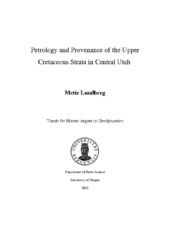| dc.contributor.author | Lundberg, Mette | eng |
| dc.date.accessioned | 2015-08-10T13:22:41Z | |
| dc.date.available | 2015-08-10T13:22:41Z | |
| dc.date.issued | 2015-06-01 | |
| dc.date.submitted | 2015-06-01 | eng |
| dc.identifier.uri | https://hdl.handle.net/1956/10257 | |
| dc.description.abstract | The reservoir quality of sandstones is primarily controlled by the primary composition of the rock volume and the effects of later diagenetic processes. Much work has been done to improve the understanding of diagenetic processes, but the controls and influence of primary composition has not been studied as extensively. The objective of this thesis is to use the world-class exposures and stratigraphic framework of the Mesaverde Group in the Wasatch Plateau and Book Cliffs, Utah, USA to investigate how petrological properties vary temporarily and spatially within a paralic clastic wedge. Sandstone composition, porosity and permeability have been studied through thin section analysis and in- field permeability measurements. The results were analysed based on facies associations, and stratigraphic and lateral position in the basin. Results show that the facies association is the dominant control on the composition, especially within wave-dominated shallow marine sandstones. The proportion of carbonate grains and carbonate-cement increase palaeoseaward, while the proportion of quartz-cement and porosity decrease along with permeability. Cluster analysis shows that the carbonate grains and carbonate-cements have a high positive correlation, which indicates that the amount of carbonate-cement formed in the samples is primarily related to the amount of detrital carbonate grains. Further, the analyses of the point counting results indicate that carbonate-cement rather that quartz-cement is the controlling factor on reservoir quality of these sandstones, as the maximum burial depth was too low for extensive quartz cementation to develop. Samples with a high amount of carbonate cement typically exhibit poor reservoir quality. Lateral variations in composition within one parasequence, the Kenilworth K4 parasequence of the Kenilworth Mb., were also investigated in this study, and the results indicate no lateral variation in the sandstone composition over the 60 km long and 60 km wide study area. This represents effective redistribution of sediments along the shoreline, together with lateral homogeneity in the source area. Temporal variations on composition can also be recognised in this study. The strongest variation occurs within the Panther Tongue Mb. This member is distinct from the other members with a high proportion of chert, which implies an abrupt change in provenance during the deposition of this unit. Another significant stratigraphic trend is seen in the amount of detrital carbonate content in the Mesaverde Group. The content is gradually decreasing upwards in the stratigraphy from the Storrs Mb. of the Star Point Fm. to the Castlegate Mb. of the Price River Fm. This indicates a gradual change in provenance over time. | en_US |
| dc.format.extent | 13338867 bytes | eng |
| dc.format.mimetype | application/pdf | eng |
| dc.language.iso | eng | eng |
| dc.publisher | The University of Bergen | en_US |
| dc.rights | Copyright the Author. All rights reserved | eng |
| dc.subject | Provenance | eng |
| dc.subject | Petrology | eng |
| dc.subject | Facies control | eng |
| dc.subject | Stratigraphic control | eng |
| dc.subject | Stratigrafi | nob |
| dc.subject | petrologi | nob |
| dc.title | Petrology and Provenance of the Upper Cretaceous Strata in Central Utah | en_US |
| dc.type | Master thesis | |
| dc.description.degree | Master i Geovitenskap | en_US |
| dc.description.localcode | MAMN-GEOV | |
| dc.description.localcode | GEOV399 | |
| dc.subject.realfagstermer | http://data.ub.uio.no/realfagstermer/c019835 | |
| dc.subject.realfagstermer | http://data.ub.uio.no/realfagstermer/c008955 | |
| dc.subject.realfagstermer | http://data.ub.uio.no/realfagstermer/c021938 | |
| dc.subject.nus | 756199 | eng |
| fs.subjectcode | GEOV399 | |
